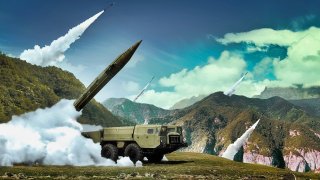North Korea’s New Satellite: A Threat?
North Korea’s recent satellite launch probably won’t add to the regime’s capabilities—at least for now.
North Korea recently conducted a successful launch of a satellite from its Sohae facility. The satellite and the rocket are both, by North Korean standards, the most advanced to date. Much has been made of this launch and the fact that it went off (at least as far as most analysts can tell) without a hitch, put a satellite into space, and at least according to the North Koreans, was able to send back images of U.S. military facilities successfully. Thus, amid all of the discussion about this event, I believe it is important to focus on the actual threat this poses to the ROK-U.S. alliance and why the North Koreans are apparently pushing hard for a “space program.”
According to the North Koreans, the launched satellite provides new intelligence, surveillance, and reconnaissance (ISR) capabilities for the regime. The system in orbit appears to capture images of American facilities located around the world and, of course, in the region. While the satellite technology is primitive by modern standards, it does add another capability to Pyongyang’s toolkit, providing intelligence needed during or before wartime. Of course, this is only one satellite. North Korea would have to launch several more to give the regime any kind of significant additional capability.
As all North Korea analysts know, Pyongyang has recently (particularly in the past year) grown closer economically and militarily with Russia. That is to say, North Korea is now sending (for a price, of course) significant shipments of artillery shells and rockets to Russia for its invasion of Ukraine. In addition, in recent months, Kim Jong-un visited Russia, where one of his key stops was a space launch facility. Reportedly, the Russians assisted the North Koreans with rocket engine challenges and may have even assisted with communications and command and control capabilities vital to launching and utilizing a satellite system in orbit. We should not be surprised if this assistance continues and, in fact, increases in terms of scope, focus, and technology.
It is obvious from both Kim’s visit to Russia and anecdotal reports we have seen coming out of North Korea that the “space program” has become a high priority. Thus, one is inclined to wonder why and why now. The fact is that joint ROK-U.S. ISR pointed at North Korea’s capabilities is probably more robust than any on Earth. Whether it is satellites, “air breathers,” reconnaissance aircraft and drones, or other more classified methods of intelligence collection aimed at North Korea, it is impossible to deny that this ISR is sophisticated, expansive, and effective in discerning the movement of troops and combat systems, and the construction of new facilities and nodes.
North Korea does not have this capability. What North Korea does have is a very robust and sophisticated HUMINT collection capability in South Korea—and elsewhere. But while this is important, it does not provide reliable and routine information on facilities, movements, and command and control. The North Koreans are now taking their first step in trying to change this. A new and advanced satellite network would give them an ISR capability that, to date, has never existed. No matter how many satellites the North Koreans put into space, its ISR capabilities would not come anywhere close to those of the ROK-U.S. alliance.
The next question then becomes, how much of a threat to allied capabilities is this? The answer is that it depends. It depends on how many satellites the North Koreans can maintain. It depends on the Pyongyang’s satellite network’s level of sophistication. Finally, it depends on how long it will take to send a large number of satellites in orbit necessary to collect a meaningful volume of intelligence on ROK and U.S. forces. Even at its best, and even with support from Russia and perhaps China, such a system would be significantly inferior to the systems that currently monitor its territory. Building and maintaining such a set of systems—which appears to be what Kim Jong-un wants—will take years to accomplish.
Of course, North Korea can also use this technology to improve its always-evolving and improving ballistic missile programs. Much of the technology used for the engines and the launch systems will be very similar. Indeed, actual ballistic missile launches could even be disguised as satellite launches if the North Koreans chose to do so.
What does all of this mean? North Korea has sent itself on a path to real ISR capabilities. While a robust HUMINT network is important to ascertain the intentions and dynamics within an adversary government, it can rarely provide timely information on military movements, systems, and capabilities. North Korea is now on the path to giving itself technical capabilities—capabilities that will never match those of its two primary targets, the United States and South Korea.
Thus, while this is a new aspect of North Korea’s ongoing defiance of regional peace and security, it remains a capability that is far weaker for the foreseeable future than what it will face during wartime or any possible contingency.
About the Author
Dr. Bruce E. Bechtol Jr. is a professor of Political Science at Angelo State University. He is also the president of the International Council on Korean Studies and a fellow at the Institute for Corean-American Studies. The author of five books dealing with North Korea, his latest work is entitled North Korean Military Proliferation in the Middle East and Africa.
Image Credit: Shutterstock.


